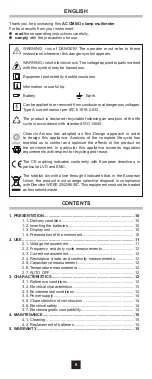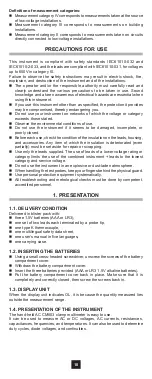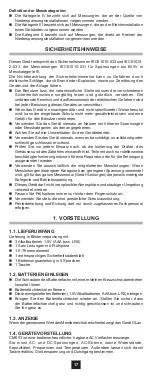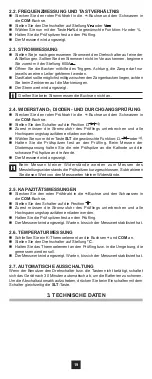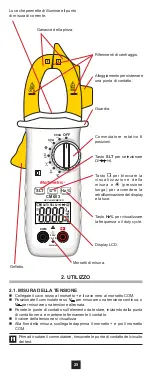
10
Definition of measurement categories:
Measurement category IV corresponds to measurements taken at the source
of low-voltage installations.
Measurement category III corresponds to measurements on building
installations.
Measurement category II corresponds to measurements taken on circuits
directly connected to low-voltage installations.
PRECAUTIONS FOR USE
This instrument is compliant with safety standards IEC61010-032 and
IEC61010-2-033, and the leads are compliant with IEC61010-031, for voltages
up to 600V in category III.
Failure to observe the safety instructions may result in electric shock, fire,
explosion, and destruction of the instrument and of the installations.
The operator and/or the responsible authority must carefully read and
clearly understand the various precautions to be taken in use. Sound
knowledge and a keen awareness of electrical hazards are essential when
using this instrument.
If you use this instrument other than as specified, the protection it provides
may be compromised, thereby endangering you.
Do not use your instrument on networks of which the voltage or category
exceeds those stated.
Observe the environmental conditions of use.
Do not use the instrument if it seems to be damaged, incomplete, or
poorly closed.
Before each use, check the condition of the insulation on the leads, housing,
and accessories. Any item of which the insulation is deteriorated (even
partially) must be set aside for repair or scrapping.
Use only the leads supplied. The use of leads of a lower voltage rating or
category limits the use of the combined inst leads to the lowest
category and service voltage.
Do not use the instrument in an explosive or dust-laden atmosphere.
When handling the test probes, keep your fingers behind the physical guard.
Use personal protection equipment systematically.
All troubleshooting and metrological checks must be done by competent,
accredited personnel.
1. PRESENTATION
1.1. DELIVERY CONDITION
Delivered in blister pack with:
three 1.5V batteries (AAA or LR3),
one set of two leads each terminated by a probe tip,
one type K thermocouple,
one multilingual safety data sheet,
one user’s manual in five languages,
one carrying case.
1.2. INSERTING THE BATTERIES
Using a small cross-headed screwdriver, unscrew the screws of the battery
compartment cover.
Withdraw the battery compartment cover.
Insert the three batteries provided (AAA or LR3 1.5V alkaline batteries).
Put the battery compartment cover back in place. Make sure that it is
completely and correctly closed, then screw the screws back in.
1.3. DISPLAY UNIT
When the display unit indicates OL, it is because the quantity measured lies
outside the measurement range.
1.4. PRESENTATION OF THE INSTRUMENT
The hand-held AC CM603 clamp multimeter is easy to use.
It can be used to measure AC or DC voltages, AC currents, resistances,
capacitances, frequencies, and temperatures. It can also be used to determine
duty cycles, diode voltages, and continuities.









